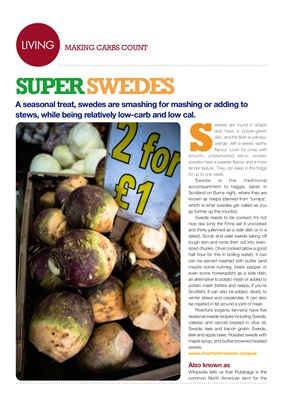
LIVINGLIVING
A reminder of what can be gleaned from reading a label and how
carbs and sugars are different.
MAKING CARBS COUNT
Swedes are round in shape
and have a purple-green
skin, and the flesh is yellowyorange,
with a sweet, earthy
flavour. Look for ones with
smooth, unblemished skins; smaller
swedes have a sweeter flavour and a more
tender texture. They can keep in the fridge
for up to one week.
Swede is the traditional
accompaniment to haggis, eaten in
Scotland on Burns night, where they are
known as neeps (derived from 'turnips',
which is what swedes get called as you
go further up the country).
Swede needs to be cooked, it's not
nice raw (only the Finns eat it uncooked
and thinly julienned as a side dish or in a
salad). Scrub and peel swede taking off
tough skin and roots then cut into evensized chunks.
Once cooked (allow a good
half hour for this in boiling water), it can
can be served mashed with butter (and
maybe some nutmeg, black pepper or
even some horseradish) as a side dish,
an alternative to potato mash or added to
potato mash (tatties and neeps, if you're
Scottish). It can also be added, diced, to
winter stews and casseroles. It can also
be roasted in fat around a joint of meat.
Riverford (organic farmers) have five
seasonal swede recipes including Swede,
celeriac and carrots braised in olive oil;
Swede, leek and bacon gratin; Swede,
leek and apple bake; Roasted swede with
maple syrup; and butter-browned braised
swede.
www.riverford/swede-recipes
Also known as
Wikipedia tells us that Rutabaga is the
common North American term for the
SUPER SWEDES